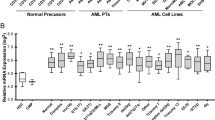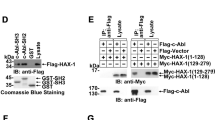Abstract
The effects of HIV-1 Tat protein on mitochondria membrane permeability and apoptosis were analysed in lymphoid cells. In this report we show that stable-transfected HIV-Tat cells are primed to undergo apoptosis upon serum withdrawal. This effect was observed in both the Jhan T cell line and the K562 cells, the latter expressing the bcr-abl chimeric gene, which confers resistance to apoptosis induced by different stimuli. Using a cytofluorimetric approach we have determined that serum withdrawal induces a disruption of the transmembrane mitochondrial potential (Δψm) followed by an increase of reactive oxygen species (ROS) and the subsequent DNA nuclear loss in K562-Tat cells but not in the K562-pcDNA cell line. These pre-apoptotic events were associated with the cleavage of the caspase-3, while the expression of Bcl-2, Bcl-XL and Bax proteins was not affected by the presence of Tat. Regardless of the steady state of the Bax protein, we found that in both K562 and K562-Tat cells, this protein is located in the nucleus, but after serum withdrawal its localization was mainly in the cytoplasm. The activity of caspase-3 detected in K562-Tat cells after serum withdrawal paralleled with the mitochondria permeability transition. Nevertheless, in Jhan-Tat cells the inhibition of this caspase with the specific inhibitor, z-DEVD-cmk, did not affect the disruption of the mitochondria potential induced by serum withdrawal. Interestingly, we found that HIV-Tat protein accumulates at the mitochondria in the K562-Tat cells cultured under low serum conditions, and this mitochondrial localization correlated with the Δψm disruption detected in these cells. In addition, HIV-1 Tat protein synergies with protoporphyrin IX (PPIX), a ligand of the mitochondrial benzodiazepine receptor, in the induction of apoptosis in both Jhan and K562 cells. Thus, HIV-1 Tat protein may induce apoptosis by a mechanism that involves mitochondrial PT and may contribute to the lymphocyte depletion seen in AIDS patients.
This is a preview of subscription content, access via your institution
Access options
Subscribe to this journal
Receive 50 print issues and online access
$259.00 per year
only $5.18 per issue
Buy this article
- Purchase on Springer Link
- Instant access to full article PDF
Prices may be subject to local taxes which are calculated during checkout







Similar content being viewed by others
Abbreviations
- Δψm:
-
mitochondrial transmembrane potential
- DiOC6(3):
-
3,3′dihexyloxacarbocyanine iodide
- HE:
-
hydroethidine
- PI:
-
propidium iodide
- PT:
-
permeability transition
- PPIX:
-
Protoporphyrin IX
- ROS:
-
reactive oxygen species
References
Adams JM and Cory S. . 1998 Science 281: 1322–1326.
Amarante-Mendes GP, Kim CN, Liu L, Huang Y, Perkins CL, Green DR and Bhalla K. . 1998a Blood 91: 1700–1705.
Amarante-Mendes GP, McGahon AJ, Nishioka WK, Afar DEH, Witte ON and Green DR. . 1998b Oncogene 16: 1383–1390.
Banda NK, Bernier J, Kurahara DK, Kurrle R, Haigwood N, Sékaly RP and Finkel TH. . 1992 J. Exp. Med. 176: 1099–1106.
Barre-Sinoussi F, Chermann JC, Rey F, Nugeyre MT, Chamaret S, Gruest J, Dauguet C, Axler-Blin C, Vézinet-Brun F, Rouzioux C, Rozenbaum W and Montagnier L. . 1983 Science 220: 868–871.
Buckley CD, Pilling D, Henriquez NV, Parsonage G, Threlfall K, Scheel-Toellner D, Simmons DL, Akbar AN, Lord JM and Salmon M. . 1999 Nature 397: 534–539.
Costantini P, Chernyak BV, Petronilli V and Bernardi P. . 1996 J. Biol. Chem. 271: 6746–6751.
Dalgleish AE, Beverley PCL, Clapham PR, Crawford DH, Greaves MF and Weiss RA. . 1984 Nature 312: 763–767.
Dan S, Naito M and Tsuruo T. . 1998 Cell Death Differ. 5: 710–715.
Fauci AS. . 1993 Science 262: 1011–1018.
Finkel TH, Tudor-Williams G, Banda NK, Cotton MF, Curiel T, Monks C, Baba TW, Ruprecht RM and Kupfer A. . 1995 Nature Med. 1: 129–134.
Finucane DM, Bossywetzel E, Waterhouse NJ, Cotter TG and Green DR. . 1999 J. Biol. Chem. 274: 2225–2233.
France-Lanord V, Brugg B, Michel PP, Agid Y and Ruberg M. . 1997 J. Neurochem. 69: 1612–1621.
Gajewski TF and Thompson CB. . 1996 Cell 87: 589–592.
Gougeon ML Garcia S, Heeney J, Tschopp R, Lecoeur H, Guetard D, Rame V, Dauguet C and Montagnier L. . 1993 AIDS Res. Hum. Retrov. 9: 553–563.
Gougeon ML, Lecoeur H, Dulioust A, Enouf MG, Crouvoisier M, Goujard C, Debord T and Montagnier L. . 1996 J. Immunol. 156: 3509–3520.
Green DR and Reed JC. . 1998 Science 281: 1309–1316.
Herbein G, Van Lint C, Lovett JL and Verdin E. . 1998 J. Virol. 72: 660–670.
Hirsch T, Marchetti P, Susin SA, Dallaporta B, Zamzami N, Marzo I, Geuskens M and Kroemer G. . 1997 Oncogene 15: 1573–1581.
Ho DD, Neumann AU, Perelson AS, Chen W, Leonard JM and Markowitz M. . 1995 Nature 373: 123–126.
Kim CN, Wang XD, Huang Y, Ibrado AM, Liu L, Fang GF and Bhalla K. . 1997 Cancer Res. 57: 3115–3120.
Kroemer G. . 1997 Nat. Med. 3: 614–620.
Kroemer G, Zamzami N and SusÃn SA. . 1997 Immunol. Today 18: 44–51.
Kruman II, Nath A and Mattson MP. . 1998 Exp. Neurol. 154: 276–288.
Lewis DE, Tang DSN, Aduoppong A, Schober W and Rodgers JR. . 1994 J. Immunol. 153: 412–420.
Li CJ, Friedman DJ, Wang C, Metelev V and Pardee AB. . 1995 Science 268: 429–431.
Liu XS, Zou H, Slaughter C and Wang XD. . 1997 Cell 89: 175–184.
Macho A, Blázquez MV, Navas P and Muñoz E. . 1998 Cell Growth Differ. 9: 277–286.
Macho A, Castedo M, Marchetti P, Aguilar JJ, Decaudin D, Zamzami N, Girard PM, Uriel J and Kroemer G. . 1995 Blood 86: 2481–2487.
Macho A, Hirsch T, Marzo I, Marchetti P, Dallaporta B, SusÃn SA, Zamzami N and Kroemer G. . 1997 J. Immunol. 158: 4612–4619.
Mandal M, Adam L, Mendelsohn J and Kumar R. . 1998 Oncogene 17: 999–1007.
Marchetti P, Castedo M, SusÃn SA, Zamzami N, Hirsch T, Macho A, Haeffner A, Hirsch F, Geuskens M and Kroemer G. . 1996 J. Exp. Med. 184: 1155–1160.
Marchetti P, Decaudin D, Macho A, Zamzami N, Hirsch T, SusÃn, SA and Kroemer G. . 1997 Eur. J. Immunol. 27: 289–296.
Marzo I, Brenner C, Zamzami N, Jürgensmeier JM, SusÃn SA, Vieira HLA, Prévost MC, Xie Z, Matsuyama S, Reed JC and Kroemer G. . 1998 Science 281: 2027–2031.
McCloskey TW, Ott M, Tribble E, Khan SA, Teichberg S, Paul MO, Pahwa S, Verdin E and Chirmule N. . 1997 J. Immunol. 158: 1014–1019.
McGahon AJ, Nishioka WK, Martin SJ, Mahboubi A, Cotter TG and Green DR. . 1995 J. Biol. Chem. 270: 22625–22631.
Meyaard L, Otto SA, Jonker RR, Mijnster MJ, Keet RPM and Miedema F. . 1992 Science 257: 217–219.
Meyaard L, Otto SA, Keet IP, Roos MT and Miedema F. . 1994 J. Clin. Invest. 93: 982–988.
Morana SJ, Wolf CM, Reynolds JE, Brown MK and Eastman A. . 1996 J. Biol. Chem. 271: 18263–18271.
Muñoz E, Blazquez MV, Ortiz C, Gomez-Diaz C and Navas P. . 1997 Biochem. J. 325: 23–28.
Muro-Cacho CA, Pantaleo G and Fauci AS. . 1995 J. Immunol. 154: 5555–5566.
Nishita M, Inoue S, Tsuda M, Tateda C and Miyashita T. . 1998 Exp. Cell Res. 244: 357–366.
Patki AH and Lederman MM. . 1996 Cell. Immunol. 169: 40–46.
Peña LA, Fuks Z and Kolesnick R. . 1997 Biochem. Pharmacol. 53: 615–621.
Quillet-Mary A, Jaffrezou JP, Mansat V, Bordier C, Naval J and Laurent G. . 1997 J. Biol. Chem. 272: 21388–21395.
Ray S, Bullock G, Tang C, Ibrado AM, Huang Y and Bhalla K. . 1996 Cell Growth Differ. 7: 1617–1623.
Roth J. . 1983 In: Bullock GR and Petrusz P. (eds). Techniques in Immunocytochemistry. Academic Press: London. pp. 217–284.
Salomoni P, Wasik MA, Riedel RF, Reiss K, Choi JK, Skorski T and Calabretta B. . 1998 J. Exp. Med. 187: 1995–2007.
Sastry KJ, Marin MC, Nehete PN, McConnell K, el-Naggar AK and McDonnell TJ. . 1996 Oncogene 13: 487–493.
Slater AFG, Stefan C, Nobel I, van den Dobbelsteen DJ and Orrenius S. . 1996 Cell Death Differ. 3: 57–62.
Susin SA, Zamzami N, Castedo M, Daugas E, Wang HG, Geley S, Fassy F, Reed JC and Kroemer G. . 1997 J. Exp. Med. 186: 25–37.
Susin SA, Zamzami N, Castedo M, Hirsch T, Marchetti P, Macho A, Daugas E, Geuskens M and Kroemer G. . 1996 J. Exp. Med. 184: 1331–1341.
Thornberry NA and Lazebnik Y. . 1998 Science 281: 1312–1316.
Tuosto L, Montani MSG, Lorenzetti S, Cundari E, Moretti S, Lombardi G and Piccolella E. . 1995 Eur. J. Immunol. 25: 2907–2916.
Wadia JS, Chalmers-Redman RME, Ju WJH, Carlie GW, Philips JL, Fraser AD and Tatton WG. . 1998 J. Neurosci. 18: 932–947.
Wang HG, Rapp UR and Reed JC. . 1996 Cell 87: 629–638.
Wei X, Ghosh SK, Taylor ME, Johnson VA, Emini EA, Deutsch P, Lifson JD, Bonhoeffer S, Nowak MA, Hahn BA, Saag MS and Shaw GM. . 1995 Nature 373: 117–122.
Westendorp MO, Frank R, Ochsenbauer C, Stricker K, Dhein J, Walczak H, Debatin KM and Krammer PH. . 1995a Nature 375: 497–500.
Westendorp MO, Shatrov VA, Schulze-Osthoff K, Frank R, Kraft M, Los M, Krammer PH, Dröge W and Lehmann V. . 1995b EMBO J. 14: 546–554.
Wolter KG, Hsu YT, Smith CL, Nechushtan A, Xi XG and Youle RJ. . 1997 J. Cell Biol. 139: 1281–1292.
Yang J, Liu XS, Bhalla K, Kim CN, Ibrado AM, Cai JY, Peng TI, Jones DP and Wang XD. . 1997 Science 275: 1129–1132.
Yang JC and Cortopassi GA. . 1998 Free Radical Biol. Med. 24: 624–631.
Zamzami N, Marchetti P, Castedo M, Decaudin D, Macho A, Hirsch T, Susin SA, Petit PX, Mignotte B and Kroemer G. . 1995 J. Exp. Med. 182: 367–377.
Zamzami N, Susin SA, Marchetti P, Hirsch T, Gómez-Monterrey I, Castedo M and Kroemer G. . 1996 J. Exp. Med. 183: 1533–1544.
Zauli G, Gibellini D, Celeghini C, Mischiati C, Bassini A, La Placa M and Capitani S. . 1996 J. Immunol. 157: 2216–2224.
Zha J, Harada H, Yang E, Jockel J and Korsmeyer SJ. . 1996 Cell 87: 619–628.
Acknowledgements
This work was supported by CICYT grant to SAF98-0046 to E Muñoz. The authors wish to thank Ms Carmen Cabrero-Doncel for assistance with the manuscript.
Author information
Authors and Affiliations
Rights and permissions
About this article
Cite this article
Macho, A., Calzado, M., Jiménez-Reina, L. et al. Susceptibility of HIV-1-TAT transfected cells to undergo apoptosis. Biochemical mechanisms. Oncogene 18, 7543–7551 (1999). https://doi.org/10.1038/sj.onc.1203095
Received:
Revised:
Accepted:
Published:
Issue Date:
DOI: https://doi.org/10.1038/sj.onc.1203095
Keywords
This article is cited by
-
Effect of HIV-1 Tat on the formation of the mitotic spindle by interaction with ribosomal protein S3
Scientific Reports (2018)
-
HIV-1 Tat protein directly induces mitochondrial membrane permeabilization and inactivates cytochrome c oxidase
Cell Death & Disease (2012)
-
Differences in NMDA Receptor Expression During Human Development Determine the Response of Neurons to HIV-Tat-mediated Neurotoxicity
Neurotoxicity Research (2011)
-
HIV-1 Tat, apoptosis and the mitochondria: a tubulin link?
Retrovirology (2005)
-
BH4-domain peptide from Bcl-xL exerts anti-apoptotic activity in vivo
Oncogene (2003)



